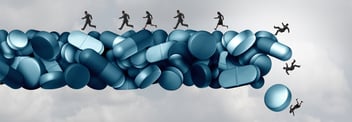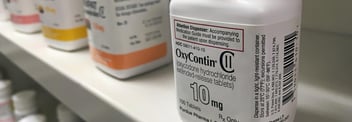Americans In Pain and Addicted: Untangling the Opioid Crisis
- Home
- Blog

Part Three: What is an Opioid, and is Accidental Addiction Possible?
Two weeks ago we began taking a deep dive into what experts are calling the worst drug crisis in American history, and in this blog, I want to begin by posing a simple question: Is it possible to get “accidentally addicted” to drugs?
Paul suffered from chronic back pain for most of his life. An avid golfer and “man’s man,” his usual method of dealing with his pain was to “tough it out”. However, over the years, additional problems began to arise, including greater pain, numbness, and intermittent weakness in both of his legs. Finally, Paul turned to his doctor for help and was prescribed opioids to relieve his symptoms. The meds worked. Paul kept refilling his medication without too much thought or worry: After all, they were doctor-prescribed. Then he lost his job and had great difficulty finding a new one. The reality was, technology had begun to replace his skill set. This threw him into an existential depression. His back pain worsened. Several antidepressants were tried by other psychiatrists but they failed to significantly improve his symptoms. Soon, he couldn’t even get through the day without an Oxy pill. Paul was a normal, hardworking man with no history of addiction. Like millions of others in the country just like him, he had become completely unintentionally hooked on opioids. He presented to our offices for evaluation and treatment of depression and addiction, including genetic testing, and the possible use of Suboxone and other therapies. His first words to me were, “Doc, I’m a complete mess. This opioid thing just kind of crept up on me. I can’t believe it! How did this happen to me?” As he began crying, my eyes welled up with tears too. He was such a likeable man, and was in so much pain—both emotional and physical. I said to him, “Paul, we will do everything possible to help you recover, including some genetic and other medical evaluations, and a consultation from an addiction specialist. You appear to have developed an ‘accidental addiction.’ As I explain to you how that can happen, I want you to remember one thing: You are not alone.”
It is absolutely possible to get accidentally addicted to drugs—and as Paul’s story demonstrates, when it comes to opioids it’s not only possible but probable. This leads us to the natural follow-up question: How in the world did this happen?
First, let me give you a brief summary of how opioids work. Opiates, found in drugs including but not limited to heroin, morphine, codeine, and hydrocodone, relieve pain by creating artificial endorphins in the brain. Endorphins are the body’s natural painkillers, and are produced organically in a variety of ways, from exercising to falling in love to eating chocolate or spicy foods to lending a hand through volunteer work. Some opioids create over 100 times more endorphins than the body produces naturally, causing feelings of happiness and joy in addition to relief from pain. Over time, however, these artificial endorphins inhibit the body’s ability to produce them naturally—and when individuals stop use of opioids, withdrawal symptoms can be severe. Death occurs not infrequently among those who relapse, after attempting to wean themselves off the drug, when the body’s newly decreased tolerance is suddenly injected by them with more opioids than it can process.
Derived from the opium poppy, opioids have a long history of addiction. Entire wars were fought over the narcotic in the nineteenth century, when China, understanding even then how highly addictive and potent opium could be, refused to accept British import of the substance onto its shores. They were right: In the years following the Brit’s victory of the opium war, up to 25% of the male population in China had begun consuming the drug regularly, causing immeasurable societal problems. This near-instant addiction played out on American shores as well. The opium poppy was first synthesized into morphine around the time of the Civil War and was doled out to soldiers to relieve their pain. This contributed to such a sharp rise in addiction rates that for much of the twentieth century, doctors and patients alike attempted to steer clear of the drug for fear of losing their minds.
Then, in 1980, a letter was published that would forever change the fate of the drug—and, as we are seeing now, of an entire generation. Despite hundreds of years of proof to the contrary, researchers from the Boston Collaborative Drug Surveillance Program published an editorial in the New England Journal of Medicine claiming that, in a rudimentary analysis of nearly 12,000 patients, who took a narcotic for their pain, only four patients with no history of prior addiction developed a dependency on the drug. Despite a lack of hard evidence, their letter opened the floodgates. Whereas doctors had previously limited the drug to cancer patients those requiring palliative care, they now began prescribing the drug for non-cancer related pain, chronic or otherwise. No doctor wants to see their patient in pain, and if opioids were said to be far less addictive than previously thought, why not prescribe them freely?
Motivated by darker reasons, some pharmaceutical companies began working to capitalize on this new market shift. The burgeoning business of opioid over-prescription reached a critical turning point when OxyContin came on the market in the mid-1990s, advertising itself as a powerful painkiller with effects that lasted just 12 hours, and with a minimum likelihood of addiction. Prescriptions skyrocketed—so did addiction. How much so? Since 1997, the number of Americans suffering from an addiction to painkillers has increased by 900%. Now, according to the CDC, over 2 million Americans are addicted and as many as 25% of those who receive the medication for non-cancer pain struggle with dependency issues.
By inventing a narrative that opioids are not highly addicting, even to those with no prior history of substance abuse or addiction, the 1980 letter, and aggressive pharmaceutical company marketing by some companies, changed everything. It created the groundwork for people like Paul to become completely dependent on a dangerous substance.
This year, the companies who brought Oxy and other similar drugs to the market are being sued by multiple parties for false advertising: These companies capitalized on the dubious research claimed by the 1980 letter and built an empire based on the premise that their drug would not be habit forming. Now, millions of Americans—entire cities, in fact—are suffering because of it.
My hope is that this backstory has provided you some context for the first question posed in this blog: When patients and doctors are working from the wrong set of facts, accidental addiction is practically inevitable. Paul had no idea what he—or his doctor—had gotten himself into. He did not realize he had a problem until he was hospitalized for unrelated reasons and was unable to receive his opioid meds. Paul recalls this withdrawal period one of the most difficult of his life. He was determined to kick the addiction and help his chronic pain through other methods like exercise, a better diet, SNRI antidepressant medication, Suboxone (buprenorphine) detox followed by maintenance, and chiropractic help.
Paul is better today, having been tapered off his Suboxone, and he is now addiction-free. But what happened to him could’ve happened to anybody—and frequently, it does. What I want you to take away from all of this is that the struggle against opioid addiction is about so much more than one person taking a pill: entire institutions were involved in creating the market for this crisis to occur, and shoddy evidence stoked the fire. If you are suffering from opioid addiction, know that you are not alone—nor is the responsibility for your addiction solely on your shoulders. With proper treatment, your addiction can be overcome. Emotional pain and physical pain are closely related, and will respond well to the type of approach that we used with Paul, evaluating and treating the Whole Person under the biopsychosocial model.
Next week we’ll dig deeper into who this crisis is affecting, and why. I hope you’ll stay with us as we work to shed light on this critical issue.
.png?width=144&height=144&name=Untitled%20design%20(34).png)



